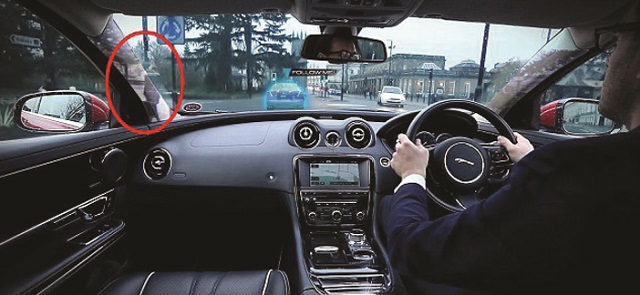
Japanese car-maker serious about reducing forward blind-spot with clever, cheap solution to help you ‘see’ through your car’s A-pillars
Toyota has filed new blueprints with the United States Patent and Trademark Office that could help drivers avoid accidents related to blind-spots.
The latest innovation is claimed to be a cheap effective solution to help drivers see ‘through’ their car’s front A-pillars, which can obscure vision when turning left or right.
Designed to address a growing problem on vehicles like heavy SUVs that need thicker pillars to pass mandatory rollover crash tests, the new device has been created to be cheaply fitted to all new Toyota models.
Toyota claims its engineers have solved the problem with carefully placed mirrors that bend light around an object. It describes the technology as a ‘cloaking device’.
Jaguar’s 360 tackled the same challenge with its Virtual Urban Windscreen concept — which was developed with Continental and employs the same technology as the Invisible Bonnet system seen on sister company Land Rover’s 2014 Discovery Vision Concept — Toyota’s solution does not project images onto the A-pillars.
But as with the Toyota’s transparent A-Pillars, Jaguar’s system has not yet been confirmed and it is not clear when we might see the new safety device on production vehicles.
Jaguar Land Rover says its project, known as ‘360 Virtual Urban Windscreen’, is designed to provide a driving view unimpeded by the vehicle’s roof-supporting pillars, the system aims to embed screens into the surface of each pillar inside the vehicle.
Each of these screens would take a live video feed from a range of cameras, arranged to cover the external angles traditionally hidden by the pillars.
“Our ultimate aim is to reduce the potential for accidents and enhance the urban driving experience”, said Dr Wolfgang Epple, JLR’s director of research and technology.
“The Jaguar Land Rover research team is developing this technology to improve visibility and to give the driver with the right information at the right time. If we can keep the driver’s eyes on the road ahead and present information in a non-distracting way, we can help drivers make better decisions in the most demanding and congested driving environments.”
The 360 Virtual Urban Windscreen promises to be intuitive by reacting to a driver’s movements, such as when they indicate or conduct a head-check to overtake, and adjusting the affected pillar’s transparency to suit.
An advanced head-up display would work in conjunction with the pillar screens and highlight the movement of other road users to the driver, via an on-screen halo projected onto the car’s virtual windscreen.
JLR is also investigating connection of the virtual windscreen system to the Cloud.
“By connecting the car to roadside infrastructure and businesses in the urban landscape, the Virtual Urban Windscreen could present information ranging from petrol station prices to the number of parking spaces available, so drivers won’t have to look for this information themselves,” the company said in a statement.
Perhaps more impressive is JLR’s development of ‘Follow-Me Ghost Car Navigation’, which projects a vehicle image ahead of the driver’s car to enable them to follow the projection to their destination.
Both technologies are believed to have been co-developed by JLR and German auto parts developer Continental, which hopes to see augmented-reality head-up displays in production vehicles by 2017.
The technology first appeared at the 2014 New York motor show in the form of an ‘Invisible Bonnet’ on the Land Rover Discovery Vision Concept, which used cameras in the vehicle’s grille to ‘paint’ a virtual image of unseen areas for the driver in the head-up display.
****
 The Independent Uganda: You get the Truth we Pay the Price
The Independent Uganda: You get the Truth we Pay the Price


